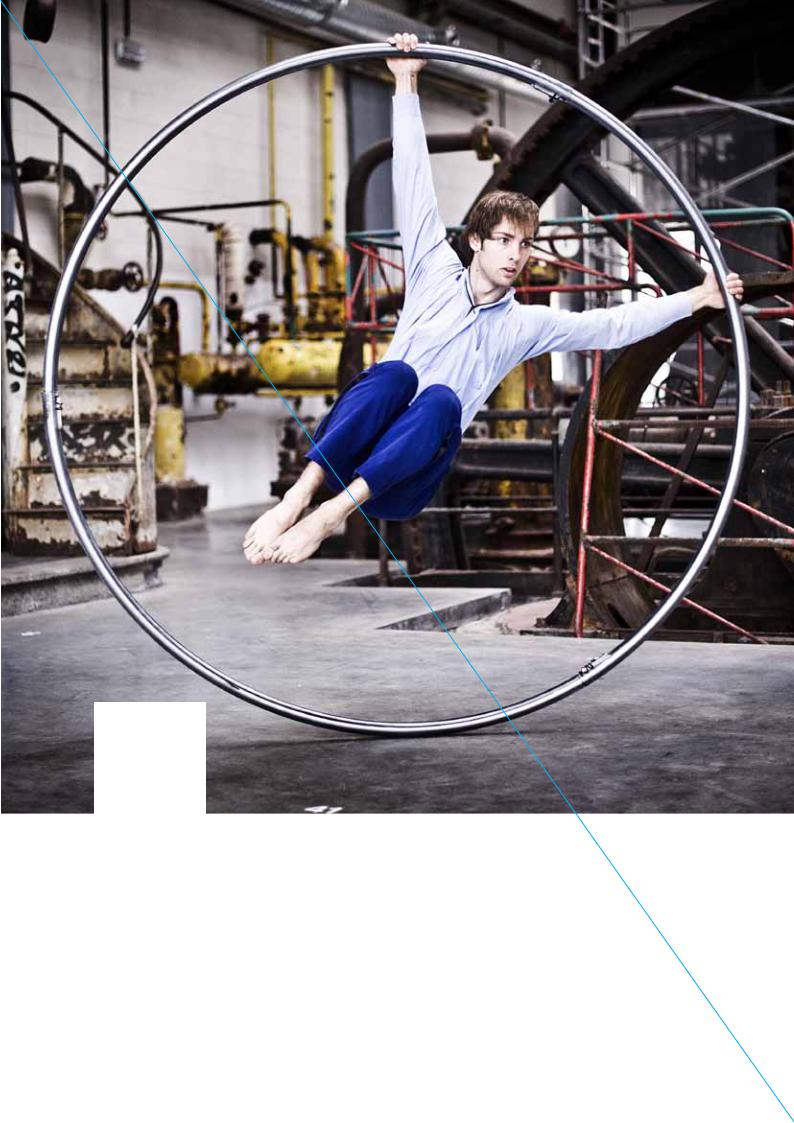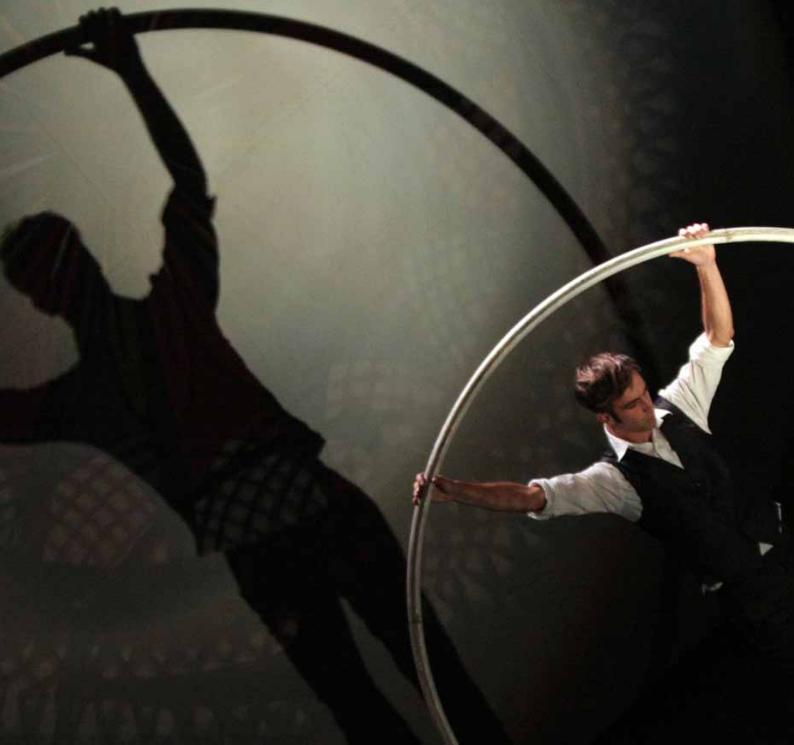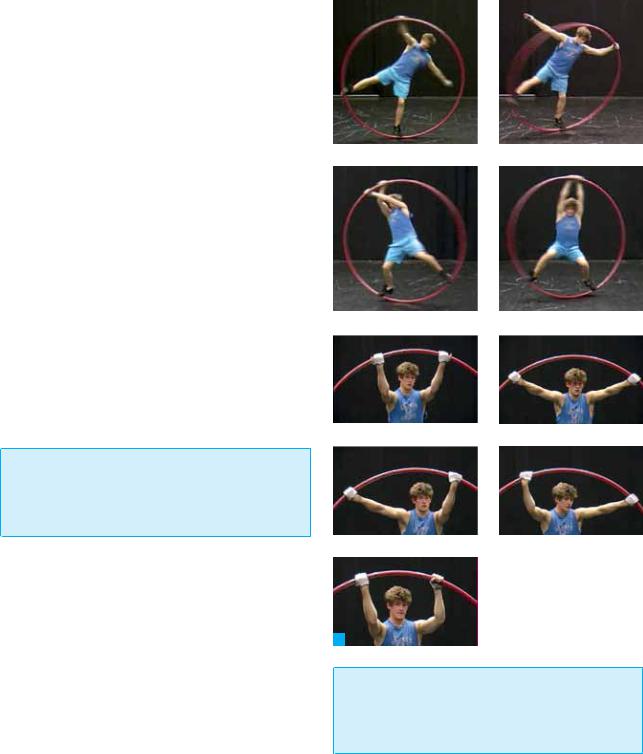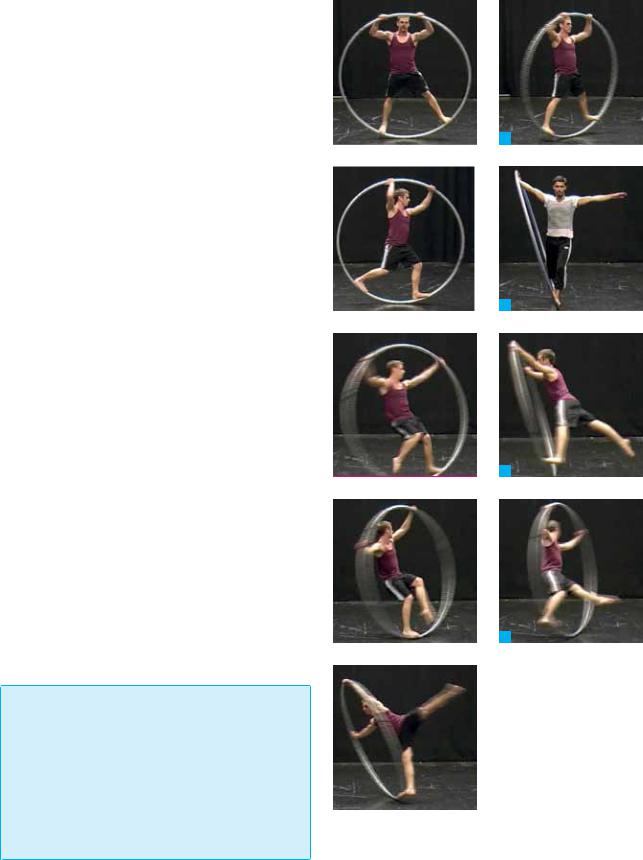
fedec_cyrwheelmanual_en_2011
.pdf
06
teaching Roue Cyr
© fedec 2011 |
CYR WHEEL 19 |

1
Group classification of moves

MOVES IN VERTICAL POSITION
1.BASIC STEPS BASIC
2.VARIATIONS ON THE BASIC STEPS
– With legs:
– With arms:
– With the body position:
– With variations in space:
3.CENTREING BASIC
4.TURNS (the wheel turns, not the body)
5.SPINS (the body turns in relation to the wheel)
6.WALKING INSIDE THE WHEEL.
HANGING MOVES
–With two arms.
–With one arm.
JUMPS
HORIZONTAL POSITIONS
1.BACKWARDS (half turn forward)
2.FORWARDS (half turn backwards)
CARTWHEELS AND COINS
CARTWHEELS.
COINS.
SPINNING ON ONE ARM
ENTRANCES
–In front.
–Behind.
EXITS
–Starting from your feet
–Starting from hands
–Starting from hanging
Each move described is accompanied by an indicator of difficulty. We chose the terms:
BASIC, INTERMEDIATE and ADVANCED.
In order to determine these indicators, we took into consideration the following criteria:
–the movements of the students inside the wheel (plane, axis and rotation),
–the movements of the wheel in space (in a fixed position and with movement),
–the number of grips on the wheel (variations from 1 to 4).
During the drafting process of this Manual, the Committee has come across a few differences in the interpretation of the terminology: “turn left”. “turn right”, “in backward/forward position” and this also happened in the different language versions, French and English. By convention, “turn left” means that the left hand guides the wheel backwards (towards the left) and the right hand pushes the wheel forward (towards the left), anticlock wise.
Also by convention, it was decided that “backward” (in hanging positions) refers to forward figures such as ”dives” and “handsprings”, while “in forward position” refers to the figures performed backwards such as the backward dive and flick.
Conveying a circus technique such as the Cyr wheel is not simply about conveying instructions for use but also about including parameters related to body movement, time and space. These are specified in the “Aims” boxes.
CYR WHEEL 21

MOVES
IN VERTICAL POSITION
1.
BASIC STEPS BASIC
Correct starting position:
One foot in the middle, arms at 45 degrees upwards to grab the wheel. With the other foot, push on the ground to make the wheel turn like a spinning top.
The wheel is tilted forward very slightly, while the body is in a vertical position.
Put the pushing foot next to the foot on the wheel. Try and turn on the spot (pivot on one spot)
Full turn involves two parts:
– the first half turn: when you put the second foot on the wheel, it pushes the wheel into the ground and the wheel tilts forward while doing a half turn (half turn forward),
the first half turn: when you put the second foot on the wheel, it pushes the wheel into the ground and the wheel tilts forward while doing a half turn (half turn forward),
– the second half turn: the body weight transfers towards the other leg, the first foot pushes the wheel into the ground, the wheel tilts backwards while doing a half turn (half turn backwards) (caution: do not pull the wheel to avoid this tilt!)
the second half turn: the body weight transfers towards the other leg, the first foot pushes the wheel into the ground, the wheel tilts backwards while doing a half turn (half turn backwards) (caution: do not pull the wheel to avoid this tilt!)
Feet position
parallel and on the soles, heels raised.
Body position
in a slight dish position: pelvis slightly behind the centre, chest sucked in (stay in front of the wheel! Do not enter it!).
Head position
straight, looking in front (far away, to the ground).
Arms position
almost straight but elbows slightly bent.
Next:
Start in the same way but put the foot which just joined the other one on the wheel further apart, with legs slightly bent, the wheel slightly tilted forward, the body in a vertical position. Try and transfer your body weight from right to left by pushing with your feet and legs (bend and straighten) and accompany the wheel movement with your arms in front/behind to push it/pull it.
01 |
|
02 |
AIMS
–Always keeping the wheel in front of the body, which is in a vertical position.
–Feeling the change and the weight transfer from one foot to the other.
–Your gaze anticipates the direction of the wheel.
–Symmetrical action of right and left (metronome).
–Keeping the pelvis relaxed and the back open in space.
–Using the direction of the right and left arms in the “push/pull” action.
22 CYR WHEEL |
© fedec 2011 |

The first sensations can be practiced with some assistance. A teacher can hold the wheel, tip it over from right to left and then make it spin back to the basic step. The student will feel the correct movement sensation in slow motion.
© fedec 2011 |
CYR WHEEL 23 |

2.
VARIATIONS
ON THE BASIC STEPS
2.1 With legs :
– With one leg raised in front, keep pushing with the other leg (right/left), BASIC
With one leg raised in front, keep pushing with the other leg (right/left), BASIC
–
 Take off the foot from the side and put it back on the wheel to push it (walk), BASIC
Take off the foot from the side and put it back on the wheel to push it (walk), BASIC
–
 Legs closed, BASIC
Legs closed, BASIC
– Legs apart (up to a split position possible, if tractioning with arms), BASIC
Legs apart (up to a split position possible, if tractioning with arms), BASIC
–Feet turned out maximally, BASIC
–Front split, BASIC
–Développé with right leg: BASIC
When doing a half turn backwards, lift a foot and flex your leg. When doing a half turn forward, stretch the back leg and push the wheel forward with your arms stretched out.Repeat this movement several times to generate rotational speed.
–Développé with left leg: BASIC
When doing a half turn forward, extend the left leg with a pelvis rotation towards the left.
During the transition of the half turn backwards, do a développé with your left leg forward.
Ease the transition in the half turn backwards by pulling with the left arm.
Repeat this movement several times to generate rotational speed.
-
 Crossed legs (one foot in front of the other) (progression towards crossed legs alternating) BASIC
Crossed legs (one foot in front of the other) (progression towards crossed legs alternating) BASIC
24 CYR WHEEL
01 |
|
02 |
03 |
|
04 |
|
|
|
|
05 |
|
|
06 |
07 |
|
08 |
© fedec 2011

–Crossed legs backwards alternating: INTERMEDIATE Start from the basic step with legs together.
In a half turn forward, bring the left foot to the centre. In the transition, cross the right leg behind and transfer the weight on that leg, then move on
to the half turn backwards.
In the following transition, cross the left leg behind and transfer the weight onto that leg, then move on to the half turn forward and so on …
–Crossed legs forward alternating: INTERMEDIATE
Same actions as the movement above except for legs crossing forward.
–Mixed crossed legs alternating: INTERMEDIATE Alternate the crossed legs steps forward and backwards.
–Basic step in a split position: INTERMEDIATE
Start from the basic step on the spot, with legs closed. Centre the wheel and push it forward.
Do a développé with your right leg and put your foot between your hands, as close as possible to the centre. Place wheel in off balance position to start again from the basic step.
AIMS
–Working on the dissociation of one body part: being aware of different changes in leg and feet positions on the wheel.
2.2With arms:
–
 One arm (right/left) (fix the shoulder of the tensed or flexed arm working), BASIC
One arm (right/left) (fix the shoulder of the tensed or flexed arm working), BASIC
– Crossed arms, BASIC
Crossed arms, BASIC
– Straight arms, closed (in hanging), BASIC
Straight arms, closed (in hanging), BASIC
–Grip with palm facing  , palm away
, palm away  , eagle grip or mixed grip
, eagle grip or mixed grip 

 BASIC
BASIC
–Asymmetric positions… BASIC
|
|
|
|
|
10 |
|
|
11 |
|
|
|
|
|
12 |
|
|
13 |
|
|
|
|
|
|
|
|
|
14 |
|
|
15 |
|
|
|
|
|
|
16 |
|
|
17 |
|
18
AIMS
–Working on the dissociation of one body part: being aware of different changes in leg and feet positions on the wheel
© fedec 2011 |
CYR WHEEL 25 |

2.3 With the body position:
–
 Arms stretched and body in an open position in front of the wheel BASIC
Arms stretched and body in an open position in front of the wheel BASIC
Two grips possible: normal and eagle grip, keeping the wheel well behind you.
– Feet and pelvis turned on one side
Feet and pelvis turned on one side
(pivot feet a quarter of a turn, feet positioned in the direction of the wheel) BASIC
–Feet and pelvis turned on one side (pivot feet a quarter
of a turn, feet positioned in the direction of the wheel)
BASIC
– Feet, pelvis and shoulders turned on one side (profile) (one hand with palm-grip, the hand behind above the head) BASIC
Feet, pelvis and shoulders turned on one side (profile) (one hand with palm-grip, the hand behind above the head) BASIC
–Same thing but changing continuously from right to left, INTERMEDIATE
–

 “Picking flowers” (squatting down, touching the floor), left arm : INTERMEDIATE
“Picking flowers” (squatting down, touching the floor), left arm : INTERMEDIATE
Start from the basic step with legs apart.
Toppling forward in a half turn, reach down the wheel with your right hand.
Rotate the trunk to the right by flexing the right leg (lower yourself towards the right).
Let the left hand slip down to the floor towards the right foot. While passing on a half turn backwards, extend your whole body backwards with a trunk rotation to the left (to help with the rotation).
05 |
|
06 |
01 02 07
|
|
floor), right arm : INTERMEDIATE |
|
|
Start from the basic step with legs apart. |
|
|
In a half turn forward, when on the right foot, let the |
|
|
left hand go down low on the wheel. |
|
|
Rotate the trunk to the left by bending the left leg |
|
|
(go down towards the right) |
03 |
04 |
Let the right hand slip down to the floor towards the |
|
– |
“Picking flowers” (squatting down, touching the |
left foot.
When passing on a half turn forward, extend your whole body backwards with a trunk rotation to the right.
26 CYR WHEEL |
© fedec 2011 |

–Flag on the left: INTERMEDIATE
Start from the basic step with legs apart. In the half turn backwards, while rotating on the left leg, put the right hand and foot together simultaneously.
While passing on a half turn forward, extend the whole body backwards with a trunk rotation towards the right.
–Flag on the right : INTERMEDIATE
Start from the basic step with legs apart.
In a half turn forward, staying under the wheel, put the left hand and leg together simultaneously when rotating on the right foot.
While passing on a half turn backwards, stretch the left leg forward and rotate the trunk to the left, with the left arm behind the wheel.
2.4 With variations in space :
–Small circular trajectory; normal rhythm of the basic steps BASIC
–Big circular trajectory; higher rhythm of the basic steps and feet pushed further (look in the direction of the trajectory desired), BASIC
–In a straight line; slightly higher rhythm of the basic steps to avoid turning in circles, almost let go of the hand and leg which are behind (accentuate the action of the arm and leg forward, not behind), look out toward the direction of the trajectory desired. INTERMEDIATE
AIMS
–To keep looking in the direction of the trajectory desired.
–Being aware of the direction of the arms while they accompany the movement.
–Feeling the trajectory in space, whether it is a straight line or a curved line.
–Being aware of the surrounding space.
© fedec 2011 |
CYR WHEEL 27 |

3.
CENTREING
Centreing means stopping the basic step to pivot on one spot (that is, not turning in a circle).
There is no longer a movement in front of or behind the wheel, so we find ourselves in a fairly stable position with the wheel slightly in front of us and the body in a vertical position.
3.1 |
|
|
|
Centreing in a frontal position BASIC |
|
|
|
|
|||
|
After the basic steps, straighten up on tiptoes |
01 |
|||
|
|
||||
|
with straight legs. |
|
|||
|
The wheel and the body straighten up/join at the |
|
|||
|
same time (come in slightly inside the wheel, |
|
|||
|
the tilt between the wheel and the body decreases). |
|
|||
|
The body accompanies this action in a tensioned |
|
|||
|
position (dish). |
|
|||
3.2 |
|
Centreing in a profile position BASIC |
|
||
|
|
||||
|
|
||||
|
Centre. |
|
|||
|
03 |
||||
|
|
|
|
|
|
Turn the body one quarter of a turn. Stay inside the wheel.
It is also possible to centre starting from a profile position.
3.3  Variation on the profile position BASIC
Variation on the profile position BASIC
After having centred the profile position,
leave the hand at the front and place the wheel on the side (in a more tilted position).
Place the wheel above your head again and place |
05 |
|
|
your free hand behind the other. |
|
Leave the hand in front and tilt the wheel on the other |
|
side. |
|
3.4 Centreing with “développés” BASIC
–
 After a few développés (see p.24) with the right leg,straighten up inside the wheel with two feet fixed, in order to centre
After a few développés (see p.24) with the right leg,straighten up inside the wheel with two feet fixed, in order to centre
– |
|
|
|
|
|
After a few développés with the left leg, |
|
|
|
|
|
||||
|
|
|
|
|
07 |
||
|
straighten up inside the wheel with two feet fixed, |
||||||
|
|
||||||
in order to centre
AIMS
–Following the direction of the wheel with the leg in développé.
–Keeping correct form of the foot movement for the leg in développé.
–Feeling the acceleration of leg and arms when
centreing. |
09 |
|
–Possibility to play with the width of the développé; the rhythm will change as a consequence.
28 CYR WHEEL
02
04
06
08
© fedec 2011
